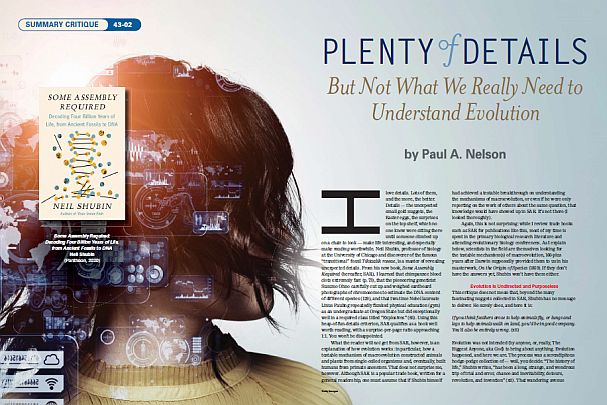This article first appeared in the Christian Research Journal, volume 43, number 2 (2020). For further information or to subscribe to the Christian Research Journal please click here.
I love details. Lots of them, and the more, the better. Details — the unexpected small gold nuggets, the Easter eggs, the surprises on the top shelf, which no one knew were sitting there until someone climbed up on a chair to look — make life interesting, and especially make reading worthwhile. Neil Shubin, professor of biology at the University of Chicago and discoverer of the famous “transitional” fossil Tiktaalik roseae, is a master of revealing unexpected details. From his new book, Some Assembly Required (hereafter, SAR), I learned that chimpanzee blood clots extremely fast (p. 73), that the pioneering geneticist Susumo Ohno carefully cut up and weighed cardboard photographs of chromosomes to estimate the DNA content of different species (129), and that two-time Nobel laureate Linus Pauling repeatedly flunked physical education (gym) as an undergraduate at Oregon State but did exceptionally well in a required class titled “Explosives” (65). Using this heap-of-fun-details criterion, SAR qualifies as a book well worth reading, with a surprise-per-page ratio approaching 1:1. You won’t be disappointed.
What the reader will not get from SAR, however, is an explanation of how evolution works: in particular, how a testable mechanism of macroevolution constructed animals and plants from single-celled organisms and, eventually, built humans from primate ancestors. That does not surprise me, however. Although SAR is a popular trade book, written for a general readership, one must assume that if Shubin himself had achieved a testable breakthrough on understanding the mechanisms of macroevolution, or even if he were only reporting on the work of others about the same question, that knowledge would have showed up in SAR. It’s not there (I looked thoroughly).
Again, this is not surprising: while I review trade books such as SAR for publications like this, most of my time is spent in the primary biological research literature and attending evolutionary biology conferences. As I explain below, scientists in the field are themselves looking for the testable mechanism(s) of macroevolution, 160-plus years after Darwin supposedly provided them to us in his masterwork, On the Origin of Species (1859). If they don’t have the answers yet, Shubin won’t have them either.
Evolution Is Undirected and Purposeless
This critique does not mean that, beyond the many fascinating nuggets collected in SAR, Shubin has no message to deliver. He surely does, and here it is:
If you think feathers arose to help animals fly, or lungs and legs to help animals walk on land, you’d be in good company. You’d also be entirely wrong. (xii)
Evolution was not intended (by anyone, or, really, The Biggest Anyone, aka God) to bring about anything. Evolution happened, and here we are. The process was a serendipitous hodge-podge collection of — well, you decide: “The history of life,” Shubin writes, “has been a long, strange, and wondrous trip of trial and error, chance and inevitability, detours, revolution, and invention” (xii). That wandering avenue of contradictory nouns just about covers the waterfront, doesn’t it? If your existence wasn’t due to this undirected cause (“chance”), then we also have that one, over there (“inevitability,” the opposite of chance), and some other ideas in the back room, or the storage unit outside.
What is not on offer, however, is a designing God. Nope. If you must, there is a church down the street.
Physics Exhausts the Facts
Shubin does not explain why directed evolution, or its first cousin intelligent design, are off the list of candidate scientific explanations for the origin and diversity of life. He doesn’t have to, as that presupposition — namely, design just isn’t science, whatever the evidence shows — has been the ground rule of historical biology since the late 19th century. This rule usually goes by the name of methodological naturalism (hereafter, MN), which the National Academy of Sciences defined in 1998 as “The statements of science must invoke only natural things and processes.”1 At first glance, MN seems entirely reasonable: we don’t want science chasing after every magical whim or spooky entity somebody dreams up. Stick with what we can test.
But “natural,” the key word in the National Academy’s definition of MN, does not actually mean “testable.” In the context of MN, “natural” means ultimately derived from physics, without the action of mind or intelligence. Thus, you the reader, for instance, contemplating these sentences right now, comprise, at bottom, an admittedly complicated but still strictly physical system — particles in motion, and only particles. Whatever you may think or decide — for example, “So here is Paul going on and on again about why he dislikes MN, but I think I might take a look at Shubin’s book, it sounds cool” — will turn out to be the causal consequence of physical events and objects, but those decisions were not caused by you (as an irreducible and unique agent). There is no you, really. Only physics.
Probing A Crazy Asymmetry:
MN Only Takes, But Doesn’t Give
Shubin came to the University of Chicago as faculty in 2000, after I had already finished my philosophy of science PhD there (1998), so I never had a chance to take a biology or evolution course with him. Occasionally, in later years, I would see him around the Hyde Park campus, at colloquia or larger meetings, such as the 2009 sesquicentennial celebration of Darwin’s Origin of Species — but no opportunity arose for an in-depth discussion of the issues raised by his work, such as the rationality of MN.
Still, one can hope. Maybe Shubin will see this review, and the chance will arrive. The French language possesses an apt phrase for the witticism that occurs to one, alas, too late to be of any use, as one is leaving the party: l’esprit de l’escalier — staircase wit. If Shubin and I could have talked while I was still a graduate student, here is the “staircase wit” topic I would have put uppermost on my list, as we sat down with our coffee: MN only takes options away from investigators, but gives them none. That is a crazy rule for any scientist, or thinking human being, to adopt.
The reason MN only takes options away from us stems from the core intelligent design claim, namely, that genuine agency or intelligence is irreducible to physics. If that irreducibility proposition is true, design will always exist as a separate mode of causation, distinct and unique, which cannot be lost in the growth of physical knowledge. Design will be a causal option in addition to, with explanatory power over and above, what “natural” causes provide. Thus, if we throw out design, we will never get it back from physics alone — a loss in power, with no replacement.
The paragraph above contains a lot of philosophy jargon, so let me give you a straightforward analogy. Suppose you are an insurance claims investigator called to the scene of a devastating house fire. You meet the local fire department officials at the scene, and they show you the following:
- Multiple independent traces of a petroleum accelerant (gasoline).
- Missing valuables (the stereo, large-screen television, and kitchen appliances were all removed before the fire).
- Several points of origin in the burn pattern (the fire appears to have started in many locations at the same time).
And you know that the homeowners just tripled their “accident” coverage a few weeks before the fire.
But when you file your report, your superiors at the insurance company tell you to try again: go back to the scene and find the “natural” cause for the fire. Ultimately, they say, with their arms crossed and a scolding frown, physics must be responsible, not agency or intelligence. Crazy, right?
Crazy, of course, because the evidence at the scene might have shown a lightning strike, or a failed electrical circuit, or any number of other natural causes, where the homeowners are entirely innocent. Allowing for the possibility of design — sometimes desperate people burn things down for money — does not remove one’s ability to infer a physical or natural cause, should the evidence warrant.
But throwing out design, before the evidence has a chance to speak for itself, eliminates it from our toolbox of possibilities — and we cannot get it back. That sort of asymmetry should wake you up. Something is wrong with this picture.
The Cost of Methodological Naturalism
MN comes with a high cost. Besides rendering your personal agency or free will an illusion, because there just is no “you,” MN turns science into what may be, at day’s end, a fruitless quest.2 Here is why. Shubin himself, as a student and young professor, lived through radical shifts in the content of evolutionary theory (some of which he sketches in SAR). Take the pattern of homology, for example: the striking structural correspondence between the bones in your forearm, with (starting at the trunk, and moving out to your fingers) a one / two / five pattern, and the 1:2:5 bones in the forelimb of a bat, a horse, or a whale. When Shubin and I entered biology (at about the same time, the early 1980s), the standard textbook explanation of homology held that the anatomical similarities exhibited by different groups of organisms were best explained by the inheritance of shared genes, regulating shared developmental programs. You and whales share homologies in your limbs, and the rest of your anatomy, for that matter, because you share a common mammalian ancestor who gifted you with the genes, the DNA, causally responsible for the bones in question.
Common Ancestry Whatever the Evidence
This textbook explanation blew up, irreversibly, in the late 1980s and early 1990s, however, with the discovery that the “same” genes — defined as highly similar DNA sequences — were present and causally implicated in organisms as classically different as fruit flies, mice, and squid. Under evolutionary theory, a mouse’s camera eye and the compound eye of a fruit fly are not homologous, because no eye of comparable complexity existed in their common ancestor to provide the precursor sensory organ whose regulatory DNA would be inherited through the Tree of Life. According to common descent, which Shubin holds, non-homologous eyes should be developmentally regulated by non-homologous genes.
Yet the same gene (and its protein product, a DNA-binding regulatory element) mediates the development of eyes in mice and flies, even though their respective developmental pathways, when viewed at large scale, look divergent. It is hard to imagine a discovery less congruent with the standard evolutionary story that Shubin and I were both taught as undergraduates. One response to a counterintuitive discovery like this is the blunt assessment of the late evolutionary developmental biologist Eric Davidson (d. 2015), of Caltech. Davidson, no friend of intelligent design, said that standard neo-Darwinian theory was “just total nonsense.”3
Shubin and colleagues, by contrast, renamed homology as “deep homology.”4 Despite the falsification of the textbook account by unexpected new data, evolution could be spared embarrassment if the adjective “deep” stepped protectively in front of “homology,” changing the meaning of that term to whatever we find, common ancestry is still true. (That’s not really what they said, of course, but that is the practical outcome.5)
MN spoils our quest to understand homology, and turns biology into a fruitless enterprise, by taking away explanatory options in the face of unexpected findings. Maybe the reason we see the “same” regulatory gene in the developmental pathways of flies, squid, and mice is that the DNA sequence represents an intelligently-caused module, which a designer can re-deploy if he so chooses in globally different systems. The module appears the “same” (i.e., exhibits sequence similarity) not because of common descent, but because of its functional role of binding DNA — just as the character strings “read,” “common,” “turns,” “friend,” and “geek” show up as the “same” as lower-level modules here, in this article, as they would in a young adult paperback novel your teenager might peruse in the van on the way to summer camp. Same words (functional modules) but used in wholly different higher-level contexts.
That’s quite reasonable, might even be true, and yet is forbidden by MN. That is bad news for science, and bad news for human understanding. Still — Shubin is a charming writer, tells a good story, and will shower you in amusing details. SAR is worth a look. —Paul A. Nelson
Paul A. Nelson, PhD, is an adjunct professor in the master’s program in science and religion at Biola University and a fellow of the Center for Science and Culture of the Discovery Institute.
NOTES
- Teaching About Evolution and the Nature of Science (Washington, DC: National Academy Press, 1998), 42.
- Read more about what’s wrong with MN in my online essay, “Methodological Naturalism: A Rule That No One Needs or Obeys,” Evolution News and Science Today, September 22, 2014, https://evolutionnews.org/2014/09/methodological_1/.
- Eric Davidson, interview with Ute Deichmann, Developmental Biology 420 (2016): S20–S29; S25.
- Neil Shubin, Cliff Tabin, and Sean Carroll, “Deep Homology and the Origins of Evolutionary Novelty,” Nature 457 (2009): 818–23.
- For further study, see Jonathan Wells and Paul Nelson, “Homology: A Concept in Crisis’” Origins and Design 18, 2 (1997), Access Research Network, http://www.arn.org/docs/odesign/od182/hobi182.htm. For more in-depth study, see Paul A. Nelson, “Why Building Animals Is Hard: The Logic of Development, Common Descent, and the Origin of Animal Body Plans,” Discovery Institute, May 7, 2020, https://www.discovery.org/m/2020/05/Building-Animals-Is-Hard-050820.pdf.









